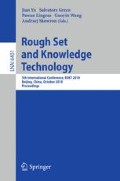Abstract
In this paper a clustering algorithm based on the minimum spanning tree (MST) with neighborhood density difference estimation is proposed. Neighborhood are defined by patterns connected with the edges in the MST of a given dataset. In terms of the difference between patterns and their neighbor density, boundary patterns and corresponding boundary edges are detected. Then boundary edges are cut, and as a result the dataset is split into defined number clusters. For reducing time complexity of detecting boundary patterns, an rough and a refined boundary candidates estimation approach are employed, respectively. The experiments are performed on synthetic and real data. The clustering results demonstrate the proposed algorithm can deal with not well separated, shape-diverse clusters.
Access this chapter
Tax calculation will be finalised at checkout
Purchases are for personal use only
Preview
Unable to display preview. Download preview PDF.
References
Jain, A., Dubes, R.: Algorithms for Clustering Data. Prentice-Hall, NJ (1988)
Guojun, G., Ma, C., Wu, J.: Data Clustering:Theory, Algorithms, and Applications. ASA-SIAM Series on Statistics and Applied Probability, Philadelphis (2007)
Karypis, G., Han, E., Kumar, V.: Chameleon: Hierarchical clustering using dynamic modeling. Computer 32(8), 68–75 (1999)
Park, N., Lee, W.: Statistical grid-based clustering over data streams. SIGMOD Record 33(1), 32–37 (2004)
Zahn, C.T.: Graph-theoretical methods for detecting and describing Gestalt clusters. IEEE Transactions on Computers C 20, 68–86 (1971)
Shi, J., Malik, J.: Normailized cuts and image segmentation. IEEE Trans. Pattern Anal, Mach. Intell. 22(8), 888–905 (2000)
Davies, D.L., Bouldin, D.W.: A Cluster Separation Measure. IEEE Trans. Pattern Analysis and Machine Intelligence 1, 224–227 (1979)
Bock, H.H.: Clustering Algorithms and Kohone Maps for Symbolic Data. Society of computational statistical, 1–13 (2002)
Author information
Authors and Affiliations
Editor information
Editors and Affiliations
Rights and permissions
Copyright information
© 2010 Springer-Verlag Berlin Heidelberg
About this paper
Cite this paper
Luo, T., Zhong, C. (2010). A Neighborhood Density Estimation Clustering Algorithm Based on Minimum Spanning Tree. In: Yu, J., Greco, S., Lingras, P., Wang, G., Skowron, A. (eds) Rough Set and Knowledge Technology. RSKT 2010. Lecture Notes in Computer Science(), vol 6401. Springer, Berlin, Heidelberg. https://doi.org/10.1007/978-3-642-16248-0_76
Download citation
DOI: https://doi.org/10.1007/978-3-642-16248-0_76
Publisher Name: Springer, Berlin, Heidelberg
Print ISBN: 978-3-642-16247-3
Online ISBN: 978-3-642-16248-0
eBook Packages: Computer ScienceComputer Science (R0)

